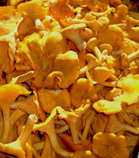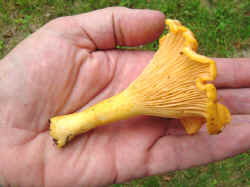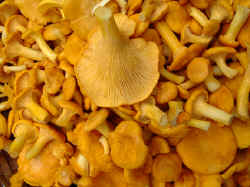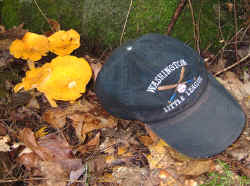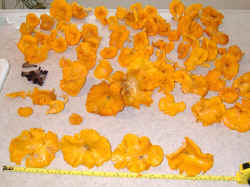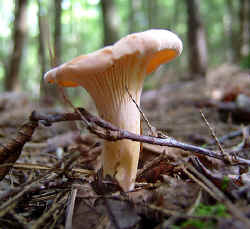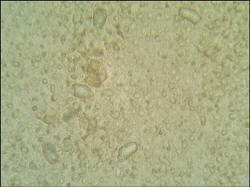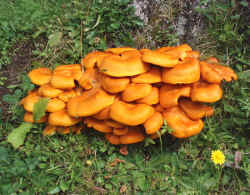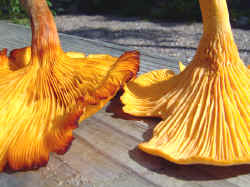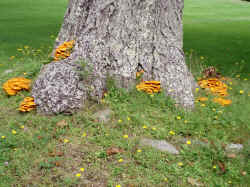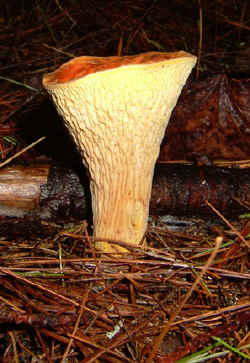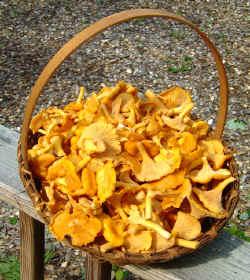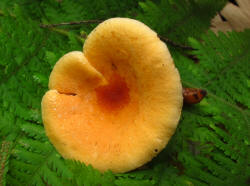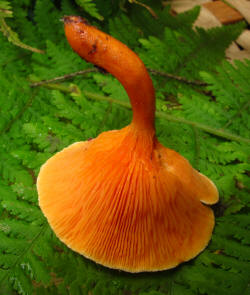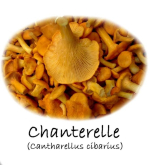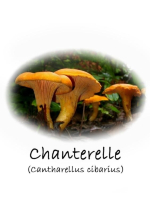|
|
A New England and Eastern Canada Edible and Medicinal Mushroom Resource |
|
Home
Chanterelle (Cantharellus cibarius) Black Trumpet (Craterellus cornucopioides, C. cenerius, C. foetidus) Small Chanterelles (Craterellus tubaeformis, C. ignicolor) Hedgehog (Hydnum repandum, H. umbilicatum) Horse and Meadow Mushroom (Agaricus arvensis, A campestris) Parasol Mushroom (Macrolepiota procera) Shaggy Mane (Coprinus comatus) (White) Matsutake (Tricholoma magnivelare) Blewit (Lepista nuda) Oyster Mushroom (Pleurotus ostreatus, P. populinus)
King Bolete (Boletus edulis) Boletus variipes and other. Two Colored Bolete (Boletus bicolor) Maitake (Grifola frondosa) Chicken of the Woods (Laetiporus sulphureus) Dryads Saddle (Polyporus squamosus)
Morels (Morchella esculenta, M. elata) Puffballs (Calvatia gigantea, Calvatia cyathiformis, others) Lobster Mushroom (Hypomyces lactifluorum) Aborted Entoloma (Entoloma abortivum)
Medicinal Mushrooms Maitake (Grifola frondosa) Reishi (Ganoderma tsugae, G. lucidum) Turkey Tail (Trametes versicolor) Chaga (Inonotus obliquus) Artist's Conk (Ganoderma applanatum)
Collecting, Photographing and
Cooking Collecting
Tips Evaluating
Flavor Dyeing Fabrics and Paper with Mushrooms
|
Chanterelle The Chanterelle is found and enjoyed by people all over the world. It has many names, pfifferling, girolle, gallinacci, but fortunately, in this country, it goes by the name chanterelle or occasionally by golden chanterelle. It is fairly common and easy to spot and grows in great profusion some years. Recent molecular evidence reveals that Cantharellus cibarius is a European species. Chanterelles are a complex of very closely related edible species that will eventually be assigned new species names. Morphological (physical) among these species differences are very subtle. Chanterelles are very beautiful and have great taste and aroma not to mention great eye appeal on a plate. Chanterelles are certainly one of my favorites. Cap (pileus) 3/4 - 5 inches wide convex at first with inrolled margin (edges) often becoming funnel shaped with a wavy margin. It can be quite irregularly shaped. The color ranges from egg yolk yellow to yellow orange and rarely has pink tones. The pink/peach chanterelle is called Cantharellus persicinus by some mycologists. Older specimens are more likely to be more orange especially after being rained on a few times. Specimens that receive a lot of sun can bleach out toward a whitish color and have a slightly leathery appearance. Since they can persist for 2 or 3 weeks algae may grow on top giving it some greenish tones. This is fairly common in wet mossy areas with shade. Gills are actually ridges that are forked and usually with blunt edges that are the same color as the rest of the mushroom. They are often quite wavy and always run down the stem (decurrent). Be sure to click the pictures above for a larger image and an idea of the varying shapes. The gills can be a little sharper edged and deeper than the description in some field guides would suggest. Stem (stipe) The length of the stem is usually similar to the width of the cap and about the same color as the rest of the mushroom. Flesh is yellowish white Spore print will be whitish to slightly yellow. When and where to find them (ecology) Chanterelles are mycorrhizal meaning they associate with trees and possibly some other bushes or plants. I think they sometimes associate with mosses too but trees will still be around. No trees, not a chanterelle. A lot of moss is a good indicator some may be around although they may not grow in the moss but nearby. In the early part of the season starting at the end of June, they will be mostly around eastern white pine but other trees are possible too. As the season progresses, the can be found under a wide variety of trees with oak, hemlock, and balsam fir being likely candidates. Birch, beech, spruce and other species may also support them. I have found only one under red maple ever. I have found quite a few in poison ivy and occasionally in low bush blueberries that were fairly near trees. They can grow in both uplands and lowlands and can often be found in "washes" or along trail edges and country dirt roads with mixed woods and a lot of shade. I have always found edges to be interesting. You can come to a dirt road edge or trail edge and find a lot. Although it is easy to imagine that the woods interior will hold many more, that is often not the case. I think the compacted earth of the trail or road may cause the mycelium to react by fruiting. They are fairly bug resistant. Once in a while one may have a maggot or two but in general they are not present. Slugs may take some. In the summer of 2007 it was very dry and there are not many mushrooms growing. The chanterelles have been quite a bit buggier than normal. The flies probably lay eggs there because they have fewer choices. July to September are likely to be the biggest months but a few may come up as late as November. 2006 was very rainy and there was a bumper crop. In fact, in over 30 years of collecting, it was by far the best year producing both the most and the largest specimens I have ever seen. Moderately rainy weather seems to be good. Preparation The chanterelle is a truly wonderful mushroom when sautéed but really is not that great as tempura. As a dried product it does not reconstitute well for cooking but makes a great powder for seasoning when used in small quantity or flavoring when used in larger quantity. Chanterelle powder added to Alfredo or a béchamel based sauce is truly outstanding. It's flavor subtleties make it suited to plain preparation or served with chicken, veal, pork, fish, milder flavored vegetables, rice, pasta, potatoes, eggs, nuts or fruits. Sautéed or pan fried chanterelles may be finished with cream for an easy but elegant sauce. Mixing with strong flavored foods is not recommended. It's not the right mushroom for steak. Those who mix chanterelles with white button mushrooms should be sent to a culinary detention facility for intensive retraining! Step away from the mushrooms! Move out of the kitchen and keep your hands in plain sight! If you have the luxury of having enough to make powder, you can make chanterelle flavored vinegar, oil, or liquor. Mushroom powder is strong stuff. It is likely to impart two or three times more flavor than reconstituted dried whole mushrooms. Comments It is said that chanterelles smell like apricots. I consider that a stretch but they do have a fruity, perfume-like aroma that becomes very noticeable if they are in a bag or closed container for a few minutes. To me it is chanterelle aroma. It can have a mildly peppery taste. I noticed the peppery character when I made some chanterelle liquor. Chanterelles can look somewhat like the poisonous jack-o-lantern seen further down this page. Jack-O-Lanterns have sharp edged gills and pumpkin orange color growing in dense bunches (cespitose). Chanterelles also look somewhat like the so-called false chanterelle (Hygrophoropsis aurantica). False chanterelles have close sharp edged gills, thinner stems, and often orangey brown tones. They may not be the same color all over the fruit body the way real chanterelles are. They are not fragrant. Some say false chanterelles are mildly poisonous while others regard them as merely a culinary disappointment. Don't eat them. Chanterelles can be used for dyeing wool, some fabrics, or paper and will yield a muted yellow color with wool when ammonia is used as a mordant.
Jack-O-Lantern . Once you have positively identified chanterelles, you should never make a mistake with these two species. Side by side they don't look that much alike. Chanterelles NEVER grow in the ways pictured below. Find more information here: Cantharellus
cibarius at MushroomExpert.com
If you like my photography, I have products like tee
shirts, aprons, coffee cups, and other items
available here
>
Copyright 2012 Mushroom-Collecting.com. All rights reserved. Use of this site will constitute your acceptance of the disclaimer. |
